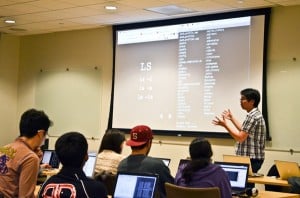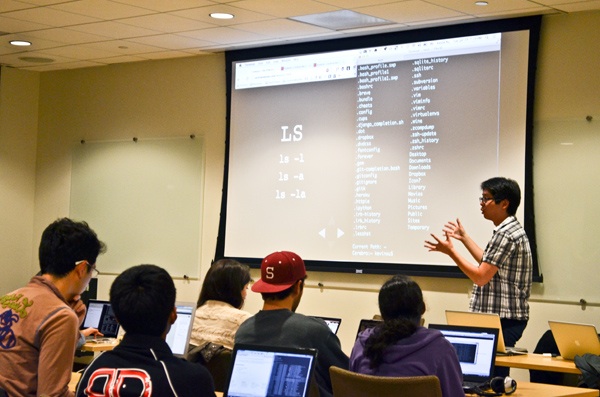
When Kingston Tam ’13, co-president of Stanford Design Initiative (SDI), surveyed students on the SDI mailing list about what technical skills they would like to learn, he was surprised to find that almost all of the 100 respondents gave the same response: web design.
Tam shared the results of the survey with his friends Charlie Guo ’13 and Kevin Xu ’13, who share his passion for web development. The three began to discuss the possibility of creating their own informal course to fulfill student demand for learning web development skills and to fill a gap they saw in Stanford’s Computer Science (CS) Department.
“We see ourselves as unique in the CS Department as we really like building things for the web,” Xu said. “People just kept asking us to teach them how to build things.”
After a month of planning, Cardinal WebDev was born. Held in the Arrillaga Wellness Room, the class is independent from the University. The 35 enrolled students are not given course credit and do not receive a grade at the end of the course. Students are often shown live coding and then given time to experiment with their own projects or solve quick challenges in class. The last half of the nine-week course will be focused on final projects that the students create, a testament to the founders’ “learning by doing” philosophy.
According to Tam, the highly interactive nature of the course differentiates it from the average class offered by the CS department.
“It’s focused on how you set up your own project and get started from nothing, and I think that’s something that a lot of CS classes lack nowadays,” Tam said.
Anjney Midha ’15, who is currently enrolled in the course, said that the practical rather than theoretical focus is one of the most appealing aspects of Cardinal WebDev. Midha was one of the select few allowed to enroll in Cardinal WebDev; over 80 percent of the applicants were turned away.
“I would say that it is probably one of the most enjoyable and applicable classes I have taken,” Midha said. “The lectures are accompanied by actual coding labs so it is going on simultaneously, and I’ve never had that experience. I would love to see that in more Stanford classes.”
Over 200 students applied for the course, which Xu credits to the fact that each of the three founders has extensive experience with web design. Guo is the co-founder of ClassOwl, Tam is the co-president of the Stanford Design Initiative and Xu is the Chief Branding Officer of the Business Association of Stanford Entrepreneurial Students (BASES).
“It was more or less our clout on campus that made it so popular,” Xu said. “When we first put up a website, people were like, ‘These people together are teaching a class?’”
Midha said he was drawn to the course during his search for a hands-on introduction to web development, which he said he could not find in Stanford’s official course offerings. He was even more eager to enroll after learning who the instructors were.
“I was really impressed by all three of their backgrounds, and I thought that the team together is an amazing complement to each other,” Midha said. “Each of them has a different area of expertise, and I thought that it was an amazing team to learn from.”
Choosing between the applications was difficult for the trio. The first criteria for admission was the completion of CS106A, as Cardinal WebDev is focused on more advanced programming instead of teaching the basics. However, Xu said that commitment and enthusiasm were weighted more heavily than programming experience.
“Commitment was number one, and we also wanted people who would feel even more awesome after taking the class,” Xu said. “We didn’t want someone who knows everything already.”
Current students include Graduate School of Business, Law School and doctoral students, along with undergraduates, local community members and even a high school student.
Among the Stanford undergraduates whose applications were accepted, Tam said that the range of majors is surprisingly diverse.
“We have polisci, econ and history majors,” Tam said. “If you just had junior CS majors, it would make the class less interesting.”
Although the University offers students the opportunity to design and run their own courses through the Student Initiated Course (SIC) program, applications for winter quarter SIC’s were due on Oct. 19 and the idea for Cardinal WebDev was not conceived until December. Tam looked into the SIC program, but decided to run the course independently instead of waiting to submit an application for spring quarter.
Tam and Xu were uncertain if the class would be held again in the future and whether or not they would apply for SIC status. However, they said the feedback they have received so far through surveys has been very positive and that students are particularly enthusiastic about learning shortcuts and industry practices that aren’t taught in typical CS classes.
Although Midha wishes that the course was offered for credit, he said that he and other students are hard-pressed to find any complaints or suggestions about the structure or content of the course. At the end of every class, the founders have a short student feedback session, which Midha said is generally the quietest part of the course.
“It’s the one part of the class where you can hear crickets chirping,” he said. “I think people are having an amazing time and having a hard time figuring out how to improve the class just because they are doing such a good job.”
